.png.transform/rendition-xs/image_image%20(1).png)
Qava, The Corner of Madrid Where Everything Tastes Like Spanish Cheese
Spain has a nearly unequaled variety of quality cheeses, principally due to one main reason: few countries boast the production of so many cheeses made with cow’s, goat’s, ewe’s and mixed milks, as well as blue, cured, semi-cured and fresh cheeses. Now, the city of Madrid has welcomed Qava, the first establishment dedicated to the sale and tasting of exclusively Spanish cheeses. We spoke with one of its founders, José Luis Martín, one of the most renowned cheese experts in Spain.
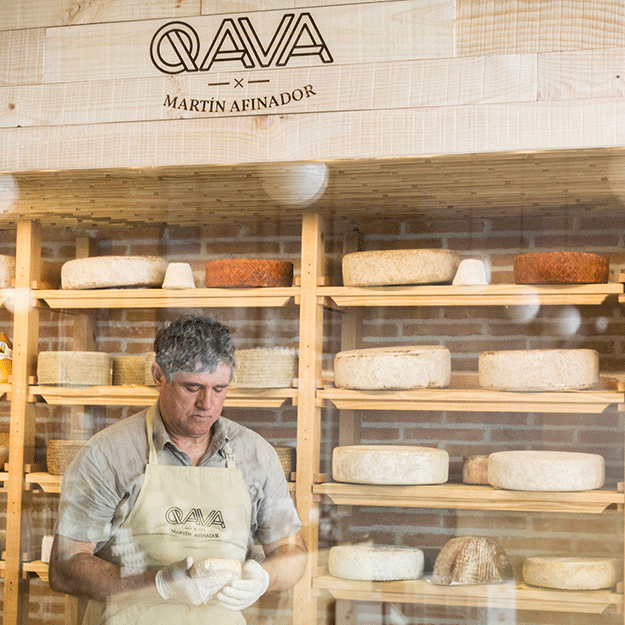
When did you come up with the idea for Qava?
I have had the idea for creating a space dedicated to caring for the product and spoiling the customer with in-depth information and the opportunity to taste the product before purchasing it for a long time. In 2014, we equipped a maturation (affinage) cave in a 16th century cistern in the Mercado Gastronómico de San Agustín, in Toledo.
Later, we moved to the center of Madrid, to the Mercado de Barceló, where we transformed the storage unit of a fruit stand into a cheese maturation cave from 2015 to 2018. And this year, my partners Antonio Llorens and Antonio Pascasio and I decided to create this space, Qava, in one of the city’s most gastronomic neighborhoods, el Retiro. This is a store dedicated exclusively to Spanish cheeses with space for the sale, tasting, training and dissemination of our Spanish cheese culture.
Until recently, Spanish cheeses were mostly cured or semi-cured cheeses, with the reference point being Queso Manchego – about which quite a bit is still unknown among both Spanish and international customers. All of this has changed enormously in recent years and we now have soft paste cheeses – mainly goat’s and ewe’s milk – that can compete with the best in the world.
What type of gastronomic experience do Qava’s customers enjoy? How would you define it?
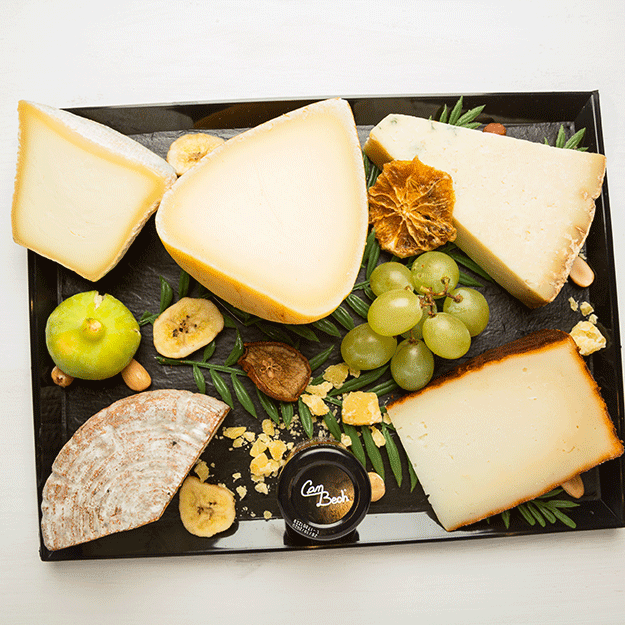
We like to share things and talk to our customers. We make suggestions in accordance with their tastes, but we also try to get them to “dare” to try other things. We have a weekly selection of twelve seasonal cheeses. The customer chooses 4 from these 12 and we serve them either cut into a wedge or a large round that weighs around 50-60 grams. We give them a knife so that they can cut it themselves at their own speed, and we give them tips on how they should eat it – from mildest to sharpest – as well as what drink would best accompany it.
Each cheese board comes with nuts and a brochette of fresh fruit, as well as a selection of good sourdough breads that are made by a baker-neighbor.
People are usually eager for our advice. In fact, nearly 90% of the time we decide what type of cheese board to serve them, and we always try to combine mild cheeses with more intense ones, as long as they haven’t told us otherwise.
We have a lot of regular, neighborhood customers and I’m sure that Qava will contribute to increasing people's knowledge of Spanish cheeses in no time. Finally, we also have an area dedicated to training and reservations. We periodically do tastings for amateur cheese lovers, as well as wine pairings, and every month we invite a cheese producer to come in and talk to us and we taste his or her cheeses. Once a month we celebrate “Cheese Day,” when people can taste more than fifty types of cheeses for a set price.
What are the 3-4 keys to the work of an expert in cheese affinage at Qava?
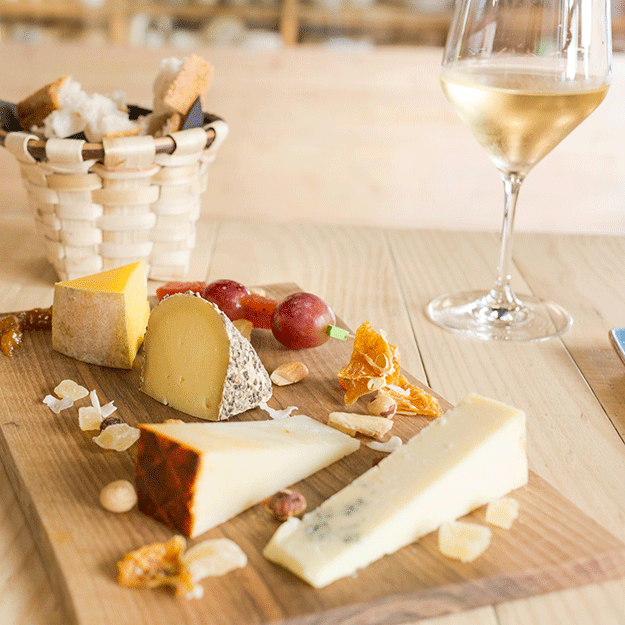
First, I select the cheeses at their point of origin, where they are made, given that I have worked as a consultant for many of these cheese-makers throughout my professional career.
The fact that I have been the director of Gourmetquesos since 2002 has also given me the opportunity to get to know practically all the varieties (of Spanish cheeses), as well as the more unusual cheeses from our country. To give you an idea, 710 cheeses were presented from all of the regions in Spain at this year’s Gourmetquesos Championship, of which I am the director and coordinator.
The procedure that we follow at Qava is that the cheeses are registered upon arrival and then put into the large cave. There they can spend between 7 days and 2 months, depending on their size, the type of paste, texture, etc.
The large format and hard paste cheeses are turned every 3-4 days, and the soft paste cheeses are turned daily for a maximum period of 2 weeks, given their very delicate nature. This is not the case with the blue cheeses, which can last a month or a month and a half. We usually order batches that are at different stages of ripening so that we can offer the cheeses at their optimum moment for consumption.
If they develop a lot of mold, then we have to brush or even wash them. The washed-rind cheeses are rinsed with salt water every 2-3 days.
A maturation cave has different “ambiences” with regard to temperature and humidity levels. The small and soft cheeses are subjected to higher humidity levels than the others, thanks to periodic salt water sprays, and we observe them daily if needed.
Basically, the 4 keys are the following:
- Watch how the cheeses arrive to the store (texture, format, height, etc.).
- Position them on the right shelves.
- Turn and take care of them, continually observing their evolution.
- Decide when they are ready for consumption and sale.
How would you define Qava’s cheese selection? Does it reflect diversity in terms of types of milk, origin and how these Spanish cheeses are made?
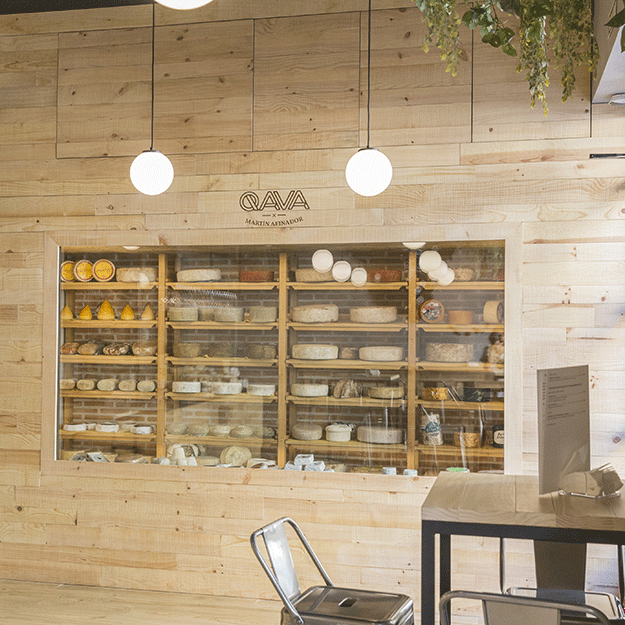
The offer is ample and generous. We work with cheeses from every region and all types of milk. In total, we have some 200 varieties throughout the year, but sometimes, at certain times of the year, we only have a small selection. For example, the tortas and other very delicate cheeses are only available in the spring.
We know all of our cheese makers and we therefore have a very special link to them. For us, the cheese maker is the protagonist and, through them, we are trying to transmit something more than just a food to our customers: a breed, surroundings, a town, etc. Of course if the cheese has Designation of Origin status we list it, but for us the most important thing is the protagonism of the product and the person who made it.
Do you put particular emphasis on raw milk and craft cheeses? How has the Spanish craft cheese industry evolved in recent years?
90% of our cheeses are raw milk cheeses because we believe that they are the expression of a territory: its pastures, its breeds and the knowledge of its people. I was making raw goat's milk cheeses in Extremadura for sixteen years, and that experience made its mark.
The evolution of the industry began in the 1990s when the concept of craft cheese appeared with a bang. Craft cheese makers’ associations and Fairs were founded, like the cheese fairs in Trujillo (Cáceres, Extremadura); in Laredo (Cantabria) and La Seu d’Urgell (Lleida, Catalonia).
That is when numerous cheese makers adapted to the health regulations of the time. Asturias and Catalonia have been the two most dynamic communities with regard to the creation of new cheeses, mostly by “neo-rural” people (those who, without any family ties to rural life, decide to leave the city behind and go live in small towns), but they appear in force all over the country, strengthening the production of certain cheeses that are currently a reference point in the industry.
We have been witnessing an authentic cheese revolution in Spain for years now, similar to that which occurred in the wine industry three decades ago.
Can you recommend the 6 most surprising cheeses that you can currently sample at Qava to us?
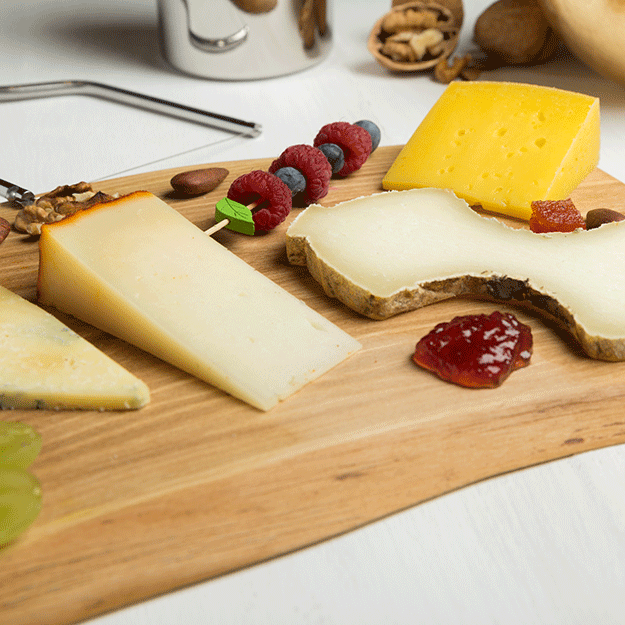
- Mercer de Baix Reserva de Familia. PDO Mahón Menorca.
Raw milk from grazing cows.
The cheeses are tasted and selected at around 3-4 months and the ones with the best sensory characteristics are stored for at least 12 months.
Toasted notes of chocolate, bakery sweets and leather.
- Zapata matured by the Hermanos Zapata in Badajoz.
Raw goat’s milk cheese coated in lard.
Notable lactic notes and subtle aromas reminiscient of Ibérico ham
- Umbría de los Charcos cheese from Quesería de la Jara, Toledo.
Raw goat’s milk. Washed rind.
Notes of plants, wet soil and nuts.
- Rvber by Quesería Castrum Erat in Serena, Badajoz
Soft paste.
Raw ewe’s milk cheese with a pimentón and mold-coated rind.
Notes of dairy, citrus and subtle fungus and balsamic aromas.
- Abuelo Ruperto Reserva from Quesos Ruperto in San Javier, Murcia.
Raw ewe’s milk cheese with a natural mold rind. 9 months maturation.
Sweet, toasted and nutty notes.
- Savel blue cheese made by Airas Moniz.
Raw milk from grazing Jersey cows. It is similar to a Stilton, but I believe it is even better.
Buttery, delicate and long lasting.
Possibly one of the best blue cheeses around today.
What is the wine and beer selection like for accompanying a cheese tasting experience at Qava?
At Qava, we think that an important part of any tasting is accompanying it with good wines and beer. In addition to the classic wines of Ribera del Duero and Rioja – which a lot of people request – we also offer some lesser known, yet very interesting wines from Liébana, Castile-La Mancha, Madrid, Jumilla, etc.
We also offer sparkling wines, which pair very well with the cheeses – particularly soft paste ones – and which are an excellent choice to accompany a cheese board.
We cannot forget fortified wines either, which pair wonderfully with our most cured cheeses, be they cow’s, goat’s or ewe’s milk.
And finally, we also offer a selection of Spanish craft beers, including IPA, Tripel, Amber Ale, Lager, etc.
Text: Rodrigo García Fernández/©ICEX
Translation: Adrienne Smith/@ICEX
Photos: @Beatriz Olalde.


